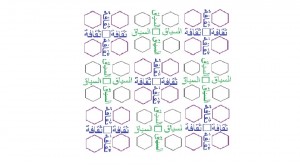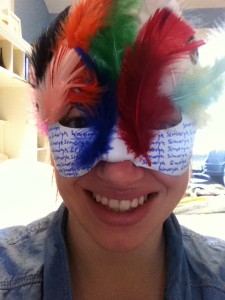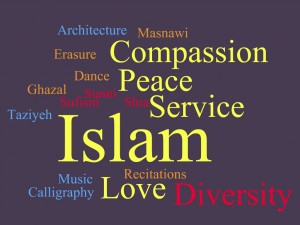Reader’s Guide
My blog is directed at people who don’t know much about Islam- particularly those people who grew up in Islamophobic America. I chose this audience because it is an audience which I connect with. I had never met a Muslim person before coming to Harvard. Everything that I knew about Islam was from the television or from a World Religion’s class I took in high school which painted Islam as a monolithic religion. Having such a limited view of Islam allows for Islamophobia to spread. If one doesn’t know anything about Islam, one will believe any lie about it- including the popular narrative that Islam is a violent religion.
I’ve seen many examples of ignorance leading to Islamophobia. Over the holidays I was talking to an older relative. He was telling our family that he sometimes goes to church with his neighbor- a woman from Indonesia. He said he was relieved to find out she was a Christian because, “I thought all of them were Muslims. And as you can guess, I’m not so fond of Muslims these days.” I was struck by the hateful tone he took on when talking about Muslims. I thought about my Muslim friends at Harvard and automatically felt defensive. Yet, I realized that such negative views about Islam and Muslims are common in the United States.
I believe that learning more about Islam- especially through a cultural studies approach- can be an antidote to such ignorance and hate. A cultural studies approach allows people to understand that there is no one Islam. Rather, there are many different ways in which people view and practice Islam. Understanding that Islam is not monolithic helps people realize that not all Muslims are the same. That is, even though Muslims committed terrorist attacks on September 11th, they do not represent all Muslims. In fact, most Muslims would vehemently condemn such acts of violence.
My blog, therefore, is a way to stand up against Islamophobia, ignorance and hate. It is a way to fight back against the popular narrative in the United States that all Muslims are the same. Through my creative responses I wanted to address common misconceptions about Islam, introduce people to iterations of Islam that they may not be familiar with, and explore the relationship between Islam and America.
The first theme of my blog- to address common misconceptions about Islam- was a common theme of the course. In fact, the great strength of the cultural studies approach is that it does just that. I had misconceptions about Islam before coming in to the course. For example, I had assumed that wearing a hijab or abaya was dictated by the Quran. Further, I had assumed that the patriarichal nature of some Muslim societies was strongly rooted in scripture. Learning about how Islam is practiced in different places helped to undermine these assumpitons. I realized that not all Muslim women wear hijab and that Muslim women were praised Quran reciters and Muslim leaders in different parts of the world. This helped me realized that the Quran was not as prescriptive as I had previously thought.
The second theme of my blog- to introduce people to iterations of Islam that they may not be familiar with- is also inspired by the cultural studies approach to Islam. In high school, I was only taught vaguely about how Islam is commonly practiced in the Middle East. We essentially just read the Quran and learned about Sharia law. The many, beautiful, ways in which Islam is practiced throughout the world was completely ignored. We did not learn about the Bersi tradition of erasure, the Iranian tradition of Taziyeh or the many forms of poetry used to show devotion to God. I had never heard of Sufism before “For the Love of God and His Prophet”. Just as this course taught me of the many ways Muslims show their devotion to Islam, I wanted to use my blog to highlight Islamic traditions that people might not know.
The third theme of my blog- to explore the relationship between Islam and America- was not an explicit theme of the course. However, I found that some of the course addressed this subject and I felt compelled to further explore it with my portfolio. The relationship between Islam and America was first introduced in this course with Professor Asani’s book Infidel of Love: Exploring Muslim Understandings of Islam. This reading opened with an analysis of how, during the 2008 elections, many people claimed that Obama was a Muslim. In doing so, they implicitly argued that being Muslim and American were incompatible- an offensive and inaccurate claim. Other readings, lectures, and movies also touched on the relationship between Islam and America. For example, ”New Muslim Cool” explored the experience of one Muslim rapper living in the United States. A few lectures mentioned the impact that U.S. foreign policy had on Islamic states in the Middle East. Finally, the hard-hitting novel “The Reluctant Fundamentalist” followed a Muslim living in New York and explored the ways in which the US demonized Islam- especially after the terrorist attacks of September 11th. This theme- though not a large one in terms of the class- seemed important to explore and I thus incorporated it into my portfolio.
My first post, “An Infidel of Love: Muslim Understanding of Islam”, serves as a sort of introduction to the blog. It directly connects to the mission of the blog- to stand up against Islamophobia and to educate people about the true nature of Islam. Further, it touches on two themes of the blog- to address common misconceptions about Islam and to explore the relationship between Islam and America. As an artistic response, I made a video collage which acts as almost a conversation between Muslims and those who don’t understand Islam. The first half of the video addresses misconceptions about Islam. It slices together videos of people calling Islam a violent or dangerous religion with videos of people explaining the peaceful nature of the religion. By doing so- it addressed misconceptions about Islam. The second part of the video explores the implications of labeling Obama as a Muslim. By doing so, it looks at the relationship between Islam and America.
My second post, “The Topaki Scroll: Geometry and Ornament in Islamic Architecture”, addresses a specific misconception about Islam- that there is one, unified form or “Islamic Art” or “Islamic Architecture”. I chose to address this specific misconception because “Islamic Art” is one subject that many people feel like they know about. Many people have seen mosques or are marginally familiar with what is often incorrectly labeled “Islamic Architecture”. Many people also associate geometric design with Islamic art. My artistic response and blog post corrects a misconception about Islam- that there is only one form of “Islamic Architecture” or “Islamic Art”. I explain that Islamic Art should not be painted in a monolithic light in my post. My artistic response portrays this by incorporating the Arabic words for “culture” and “context” into a geometric design.
My third and fourth post both tie into my theme of exposing people to different iterations of Islam. By doing so, they also help to address common misconceptions of Islam.
My third post, “Ta’ziyeh: Ritual and Drama in Iran”, exposes readers to the Iranian-Muslim tradition of the Ta’ziyeh. As I stated earlier, I had never heard of the Ta’ziyeh before this course. Yet, I think it is a beautiful and moving way to express devotion to God and Islam. I love the Ta’ziyeh because of the way it brings together past and present, because it contains a message of hope and resilience and because it encourages its audience to connect with the play. This last part inspired my artistic response. I connected to the Ta’ziyeh by writing a poem from the perspective of a character from the performance. In addition to introducing people to the concept of the Ta’ziyeh, my post also helps address common misconceptions about Islam. First, it shows how the Ta’ziyeh celebrates the female characters. This is counter to the perception that some people have that Islam is a religion which harms women. Second, by exposing people to a practice of Islam that they might not know, my post puts a hole in the narrative that there is one, unified “Islam”.
My fourth post, “The Conference of the Birds”, also exposes people to a different iteration of Islam- that of Sufism. Again, I had never heard of Sufism before this course but I loved the tradition from the moment I learned about it. I love the emphasis of each person forging a relationship with God and the concept that the divine is within us all. I tried to capture this latter concept by creating a mask inspired by “The Conference of the Birds”. I created a mask with bird-like feathers and the word “Simorgh” written over and over again. I photographed it with mirrors as a nod to the scene in “The Conference of the Birds” where Simorgh is revealed to be the reflection of the 30 birds. My post, in addition to introducing people to the Ta’ziyeh, also helps to address a common misconception of Islam- that Islam is very strict and perspective. Just as my third post does, it also challenges the assumption that Islam is a monolithic religion.
My fifth post, “The Reluctant Fundamentalist: Veil of Patriotism”, addressed my third theme in that it explores the relationship between Islam and the United States. My artistic response is a disturbing image of a woman during a US air raid in Afghanistan, veiled by an image of the American flag. My post explains both the struggles Changez, the main character from The Reluctant Fundamentalist faces and the role of the United States in the Muslim world. This post is the most jarring and cynical post in my portfolio. I did this intentionally. I want readers to understand that the relationship between Islam and America is not as simple as we often think it is. People in the United States often think of Islam as the enemy while forgetting that many Muslims around the world might view the United States as the enemy. While it is true that the September 11th attacks were committed in the name of Islam, the United States has killed thousands of innocent Muslims in the name of America. I felt like creating an image such as the one I did would be the best way to expose this to readers of the blog.
My final blog post, my alternative post entitled “Whose Islam”, serves as a conclusion to the blog. It ties together all three themes of the blog- addressing common misconceptions about Islam, exposing people to new iterations of Islam, and exploring the relationship between Islam and the United States. For my artistic response, I created a word cloud about Islam. It contains words that should be associated with Islam but- due to the Islamophobic environment that is the United States- are often not such as “Compassion”, “Love” and “Service”. It also contains words that belong to different Islamic traditions such as “erasure” and “recitation”. The word cloud is to be printed as a poster and hung up in classrooms in the United States that teaches about Islam or religion. The poster addresses misconceptions about Islam and exposes students to new iterations of Islam. This final post is solution oriented. It shows one way in which Islamophobia and orientalism can be reduced. By being solution oriented, my final post perfectly wraps up my portfolio. It shows that while many in the United States are ignorant about Islam and often irrationally hate the religion, work can be done to help facilitate understanding and appreciation for Islam and Muslims
I hope my blog is one example of such work.




